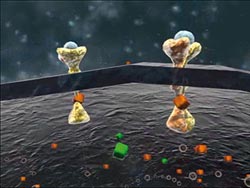Anticancer Substances Clear Next Hurdle

To activate the Axl kinase and transmit its signal to the cell nucleus, a signal substance (blue) has to bind externally and the energy carrier ATP (green) internally. The inhibitors (orange) prevent a transmission of the signal by blocking the ATP binding site.<br>Picture: Axel Ullrich/Copyright: MPI of Biochemistry<br>
These substances shall target metastasizing and drug-resistant tumors more specifically and selectively. Qurient will successively enter the tested substances into preclinical and clinical trials in order to use them in the future for drugs. The Max Planck researchers hope that if the experiments and clinical trials are successful, a drug based on the new active substances could be on the market by the end of the decade.
According to the World Health Organization (WHO), cancer causes about 7.6 million deaths per year, making it the second leading cause of death in the world after cardiovascular disease. Most cancer patients die of the disease because tumor cells spread to other sites in the body and form new tumors, so-called metastases. Therefore, there is a growing need for effective drugs. The new substances, which are the research focus of the three cooperation partners, belong to the family of highly specific Axl kinase inhibitors. In the research department headed by Axel Ullrich at the MPI of Biochemistry, the scientists Pjotr Knyazev and Robert Torka have been conducting research on the protein Axl kinase and its inhibitors for more than ten years.
The Axl kinase is a receptor protein that is found on the surface of many cell types. It recognizes specific signal substances that play a critical role in the survival and migration of cells. The researchers showed that fewer metastases develop when the Axl kinase is inactivated. In many aggressive types of cancer the Axl kinase is present at too high levels and is thus hyperactive. For this reason, the cells are constantly stimulated to grow or migrate.
“If we block the Axl kinase, we can prevent the cancer cells from migrating and forming new metastases,” said Robert Torka, explaining the effect of the new substances. The target that the inhibitors attack is located in the interior of the cell, at the Axl kinase domain. After the appropriate signaling substance is bound externally, an energy carrier (ATP) must additionally dock to the receptor internally before the signal can be transmitted to the cell nucleus. The new substances prevent the ATP from binding and the receptor from becoming activated and thus prevent the signal from reaching the cell nucleus. All Axl kinase-dependent processes are therefore blocked in the cancer cell.
Various groups of such inhibitors have already been patented at the MPI of Biochemistry. To make the individual substances even more effective against particularly aggressive, metastasizing tumors, it was necessary to generate chemical variants. The Lead Discovery Center GmbH (LDC) assumed this part of the cooperation. For example, the LCD scientists altered the substances so that they were more soluble. The researchers at the MPI of Biochemistry then tested the variants on different cancer cell lines derived from the lung, breast or pancreas e.g. for tolerance, dosage or efficacy in combination with other active substances.
The Qurient Company will successively bring the substances to preclinical and clinical trials, in order to use them later as drugs. To continue to optimize the agents further, the scientists of the MPI of Biochemistry and the LDC are participating with tests and experiments for an additional year of collaboration. Afterwards both partners take over a consulting function during the whole development process. “Our common goal is to make tumor treatments more selective and targeted to the tumor cells. The new substances are a step in the right direction,” said Pjotr Knyazev, scientist in the Department of Molecular Biology at the MPI of Biochemistry. [VS]
Contact
Prof. Dr. Axel Ullrich
Molecular Biology
Max Planck Institute of Biochemistry
Am Klopferspitz 18
82152 Martinsried
Germany
e-mail: ullrich@biochem.mpg.de
www.biochem.mpg.de/ullrich
Anja Konschak
Public Relations
Max Planck Institute of Biochemistry
Am Klopferspitz 18
82152 Martinsried
Germany
Phone: +49 (0) 89 8578-2824
e-mail: konschak@biochem.mpg.de
Media Contact
All latest news from the category: Life Sciences and Chemistry
Articles and reports from the Life Sciences and chemistry area deal with applied and basic research into modern biology, chemistry and human medicine.
Valuable information can be found on a range of life sciences fields including bacteriology, biochemistry, bionics, bioinformatics, biophysics, biotechnology, genetics, geobotany, human biology, marine biology, microbiology, molecular biology, cellular biology, zoology, bioinorganic chemistry, microchemistry and environmental chemistry.
Newest articles

High-energy-density aqueous battery based on halogen multi-electron transfer
Traditional non-aqueous lithium-ion batteries have a high energy density, but their safety is compromised due to the flammable organic electrolytes they utilize. Aqueous batteries use water as the solvent for…

First-ever combined heart pump and pig kidney transplant
…gives new hope to patient with terminal illness. Surgeons at NYU Langone Health performed the first-ever combined mechanical heart pump and gene-edited pig kidney transplant surgery in a 54-year-old woman…

Biophysics: Testing how well biomarkers work
LMU researchers have developed a method to determine how reliably target proteins can be labeled using super-resolution fluorescence microscopy. Modern microscopy techniques make it possible to examine the inner workings…





















